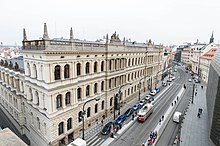Czech Academy of Sciences
This article includes a list of general references, but it lacks sufficient corresponding inline citations. (February 2013) |
Akademie věd České republiky | |
 The main building of the Czech Academy of Sciences in Prague | |
| Established | 1784 Royal Czech Society of Sciences 1953 Czechoslovak Academy of Sciences 1992 Academy of Sciences of the Czech Republic |
|---|---|
| President | Prof. Eva Zažímalová |
Administrative staff | 7771 |
| 4395 | |
| Location | , 50°4′54″N 14°24′51″E / 50.08167°N 14.41417°E |
| Website | www |
 | |
 | |

The Czech Academy of Sciences (abbr. CAS, Czech: Akademie věd České republiky, abbr. AV ČR) was established in 1992 by the Czech National Council as the Czech successor of the former Czechoslovak Academy of Sciences and its tradition goes back to the Royal Bohemian Society of Sciences (founded in 1784) and the Emperor Franz Joseph Czech Academy for Sciences, Literature and Arts (founded in 1890). The academy is the leading non-university public research institution in the Czech Republic. It conducts both fundamental and strategic applied research.
It has three scientific divisions, namely the Division of Mathematics, Physics, and Earth Sciences, Division of Chemical and Life Sciences, and Division of Humanities and Social Sciences. The academy currently manages a network of sixty research institutes and five supporting units staffed by a total of 6,400 employees, over one half of whom are university-trained researchers and Ph.D. scientists.
The Head Office of the academy and forty research institutes are located in Prague, the remaining institutes being situated throughout the country.
History
[edit]The establishment of the academy in 1992 follows several previous organizations:
- Royal Czech Society of Doctrines (Královská česká společnost nauk), 1784–1952
- Czech Academy of Sciences and Arts (Česká akademie věd a umění), 1890–1952
- Czechoslovak Academy of Sciences (Československá akademie věd), 1953-1992
In 2010 the academy adopted an open access policy to make its research outputs free to read and reuse.[1]
Institutes of the Czech Academy of Sciences
[edit]
This section needs expansion. You can help by adding to it. (June 2009) |
The official structure of the CAS consists of three areas (sciences about inanimate nature, life sciences, and humanities), each with three sections. Each of these 9 sections contains between 4 and 8 institutes. An institute is divided further into departments, laboratories, or working teams, depending on the size and the topic of the institute.
The Area of the Sciences About Inanimate Nature
[edit]Section 1: Mathematics, Physics, and Informatics
[edit]- Astronomical institute (Astronomický ústav), founded in 1954
- Institute of Physics
- Institute of Mathematics
- Institute of Computer Science (ICS)
- Nuclear Physics Institute
- Institute of Information Theory and Automation of the CAS (UTIA), founded in 1959
Section 2: Applied Physics
[edit]- Institute of Photonics and Electronics
- Institute of Physics of Materials
- Institute of Plasma Physics
- Institute of Hydrodynamics
- Institute of Scientific Instruments
- Institute of Thermomechanics
- Institute of Theoretical and Applied Mechanics
Section 3: Earth Sciences
[edit]- Institute of Geophysics (GFÚ), founded in 1920 (as the State Institute of Geophysics)
- Institute of Geology
- Institute of Atmospheric Physics, established in 1964
- Institute of Geonics
- Institute of Rock Structure and Mechanics
The Area of Life Sciences and Chemical Sciences
[edit]Section 4: Chemical Sciences
[edit]- Institute of Inorganic Chemistry
- J. Heyrovský Institute of Physical Chemistry (Ústav fyzikální chemie Jaroslava Heyrovského, named after Jaroslav Heyrovský; abbreviated: JHI respectively UFCH JH), established in 1972 – merger of the Institute of Physical Chemistry and the Institute of Polarography
- Institute of Chemical Process Fundamentals, founded in 1960
- Institute of Analytical Chemistry
- Institute of Macromolecular Chemistry
- Institute of Organic Chemistry and Biochemistry
Section 5: Biological and Medical Sciences
[edit]- Institute of Biophysics
- Biotechnology Institute
- Institute of Physiology
- Institute of Microbiology
- Institute of Experimental Botany
- Institute of Experimental Medicine
- Institute of Molecular Genetics
- Institute of Animal Physiology and Genetics
Section 6: Biological and Ecological Sciences
[edit]- Biology Centre
- Institute of Botany
- Institute of Vertebrate Biology
- Institute of Systems Biology and Ecology
The Area of Humanities and Social Sciences
[edit]Section 7: Social Sciences and Economy
[edit]- Economics Institute (EI) (departments: Center for Economic Research and Graduate Education (CERGE), founded 1991)
- Institute of Psychology
- Institute of Sociology
- Institute of State and Law
Section 8: History
[edit]- Institute of Archaeology (Prague)
- Institute of Archaeology (Brno)
- Institute of History
- Masaryk's Institute and Archives
- Institute of Art History
- Institute of Contemporary History
Section 9: Humanities and Philosophy
[edit]- Institute of Ethnology
- Institute of Philosophy (and its specialized department Centre for Medieval Studies)
- Oriental Institute
- Institute of Slavonic Studies
- Institute of Czech Literature
- Institute of Czech Language, (Ústav pro jazyk český), founded in 1946
Literature
[edit]- Franc, Martin; Mádlová, Vlasta (2014). The History of the Czech Academy of Sciences in Pictures / Dějiny Akademie věd v obrazech (in English and Czech). Prague: Academia. ISBN 9788020023407.
See also
[edit]References
[edit]- ^ "OA in the Czech Republic". OpenAIRE. Archived from the original on 5 August 2016.
External links
[edit]- Official Web site (in English)
- Czech Academy of Sciences
- National academies of sciences
- National academies of arts and humanities
- Science and technology in the Czech Republic
- 1992 establishments in Czechoslovakia
- Scientific organizations established in 1992
- Members of the International Council for Science
- Members of the International Science Council
